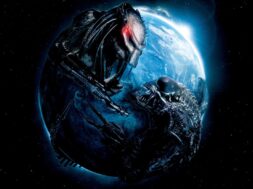Color Out of Space, an adaptation of H.P. Lovecraft’s popular story, marks the first feature film in decades helmed by Richard Stanley. After a well-received debut with Hardware, he used his newfound clout to make a more personal film; his sophomore effort Dust Devil, his last full feature released since 1992. Like Color Out of Space, Dust Devil was a personal project for Stanley and one that eschewed conventional storytelling.
Robert John Burke stars as the eponymous Dust Devil. A force of evil that wanders the desert, murdering those in his path. He preys upon the weak, the faithless, and the damned. Chelsea Field stars as Wendy, a woman on the run from her husband, a catalyst for her path to cross with the Dust Devil. Her inner and external struggles for survival take center stage, but in the peripheral is Sgt. Ben Mukurob’s (Zakes Mokae) grudge-fueled search to stop the Dust Devil. In Stanley’s hands, though, the premise isn’t nearly as linear or as lucid as it sounds.

Dust Devil is a patchwork of ideas and inspiration. Stanley drew from his childhood; urban legends of “The Vanishing Hitchhiker” that he learned from his anthropologist mother and school-aged memories were woven into the screenplay. The core concept of the Dust Devil is steeped in South African mysticism and drew from the South African serial killer known as Nhadiep, a killer so elusive that locals came to believe he was supernatural. Spaghetti Westerns were a staple of Stanley’s viewing growing up, which played an evident influence on his film, but so too did Gialli and Andrei Tarkovsky’s Mirror. All of which makes for one fevered dream of a movie.
It likely didn’t help that, upon initial release, Miramax and Palace Pictures weren’t sure what to do with the film. They’d both previously served as producing partners on Hardware, a film intentionally created to be more commercially friendly, and thought Stanley would craft another readily marketable genre movie. Moreover, they thought they were getting a more straightforward serial killer feature in the vein of Silence of the Lambs, and insisted Chelsea Field be cast as Wendy.

Studio pressures to make a product more commercially viable were high, but they were too far removed from the Namibia production to interfere much. That meant they didn’t quite know what to do with the feature they got; Miramax chairman Harvey Weinstein decided the best approach was to trim down Dust Devil from 120 minutes to 87 minutes and release it under the title Demonica. In the UK, Palace Pictures filed for bankruptcy before Dust Devil saw release, and when Polygon acquired it for release, they wound up shelving it instead. Eventually, Stanley invested a lot of money and time to re-edit the feature for Polygon to give the film a brief theatrical release.
The result is a strange film that received a nominal release, making it destined for cult status. It’s a peculiar blend of mysticism, influences, and ideas that lacks mainstream appeal. The difficulties during production and its release, in conjunction with Stanley’s firing from his follow-up project The Island of Dr. Moreau, likely played a vital role in the director’s retreat from the Hollywood system. For nearly three decades, he focused on shorts, anthology segments, and documentaries instead. It makes sense that another personal project like Color Out of Space marks his return this year.
Dust Devil might be marred for many by its lack of rooting interest in a central character, but it also makes for a wholly unpredictable experience. It’s a movie that sums up the visionary and provocative work of Richard Stanley quite well.









